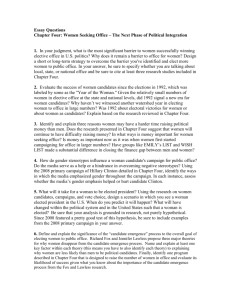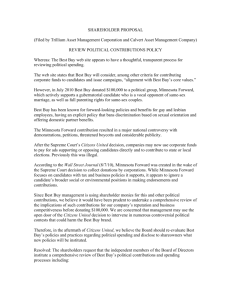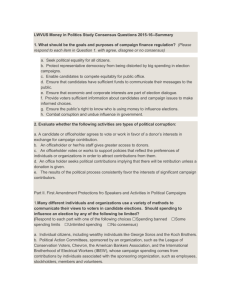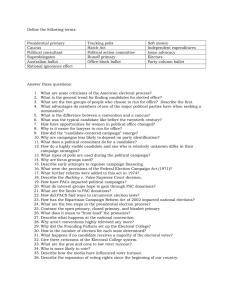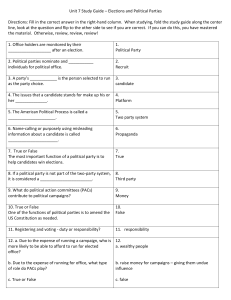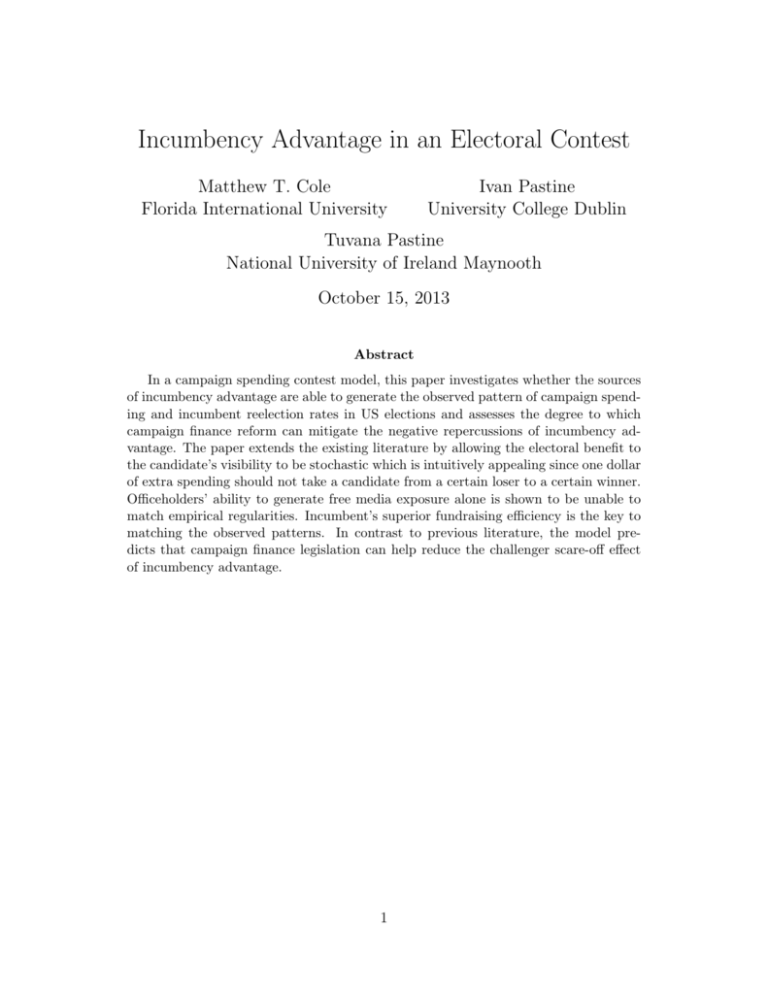
Incumbency Advantage in an Electoral Contest
Matthew T. Cole
Florida International University
Ivan Pastine
University College Dublin
Tuvana Pastine
National University of Ireland Maynooth
October 15, 2013
Abstract
In a campaign spending contest model, this paper investigates whether the sources
of incumbency advantage are able to generate the observed pattern of campaign spending and incumbent reelection rates in US elections and assesses the degree to which
campaign finance reform can mitigate the negative repercussions of incumbency advantage. The paper extends the existing literature by allowing the electoral benefit to
the candidate’s visibility to be stochastic which is intuitively appealing since one dollar
of extra spending should not take a candidate from a certain loser to a certain winner.
Officeholders’ ability to generate free media exposure alone is shown to be unable to
match empirical regularities. Incumbent’s superior fundraising efficiency is the key to
matching the observed patterns. In contrast to previous literature, the model predicts that campaign finance legislation can help reduce the challenger scare-off effect
of incumbency advantage.
1
1
Introduction
In US congressional elections incumbents are typically victorious when they run for reelection and incumbents’ campaign spending is significantly higher than challengers’.1 Empirical
studies find that incumbents tend to have a sizable electoral advantage.2 Incumbency advantage is of concern because it may lead to lower probability of victory for the challenger
even if he is equivalent or superior to the incumbent in quality. Furthermore officeholder
benefits may scare off high-quality challengers from running for office.3 We develop a contest
model of campaign spending to investigate which sources of incumbency advantage are able
to generate these empirical patterns of US congressional elections. The model is then used
to assess the degree to which campaign finance legislation can mitigate the negative effects
of incumbency advantage.
The focus is on the role of incumbency advantage abstracting from valence issues and
competition in ideological and policy space.4 We model the incumbent and challenger as
identical in all respects other than the identity of the officeholder which can generate asymmetries in access to free media exposure, fundraising efficiency and campaigning effectiveness.
The model is a reformulation of Meirowitz (2008) with an alternative micro-structure which
yields a stochastic outcome given candidate choices. Candidates simultaneously engage in
campaign spending to enhance their visibilities to the voters. At the time candidates make
their campaign decisions they are uncertain about the extent to which voters will be influenced by their visibility. The model with stochastic marginal benefit to visibility is intuitively
1
From 2000 to 2012, in US House elections, the reelection rate of incumbents who rerun varied between
85 and 98 percent. Since 2000, average incumbent spending has been about 35 percent higher than average
challenger spending, see Center for Responsive Politics.
2
The literature is vast and estimates vary. Incumbency advantage is typically estimated to be around four
percent vote share for low-level state offices and around eight percent vote share for federal and high-level
state offices, see Hirano and Snyder (2009).
3
For the significance of the scare-off effect in generating incumbency advantage, see Cox and Katz (1996),
Levitt and Wolfram (1997), Uppal (2010) and Redmond (2012) among others.
4
These may be important sources of incumbency advantage; see Anderson and Glomm (1992) and Redmond (2013) for incumbents’ first-mover advantage in spatial competition. With incomplete information
about candidate valence, Bernhardt and Ingberman (1985) shows that voters may perceive incumbents to
be less risky than challengers, giving incumbents an edge.
2
appealing since one dollar of extra spending should not take a candidate from a certain loser
to a certain winner as it would in Meirowitz (2008) and Pastine and Pastine (2012) where
the outcome is deterministic given candidates’ campaign effort levels.
It is often argued that incumbency advantage has increased in the last three decades,
partially due to 24/7 TV news coverage which gives the officeholder a significant visibility
advantage over the challenger. However we show that the officeholder’s free media exposure is insufficient to explain the pattern of spending and reelection rates.5 In equilibrium
the incumbent spends up to the point where the marginal benefit from visibility is equal
to the marginal cost of visibility. Improved access to free media exposure does not alter
this marginal calculation, hence does not affect the equilibrium choice of visibility nor the
incumbent’s probability of victory.
An advantage of the micro-structure used here is that it allows us to disentangle the effects
of fundraising efficiency and campaign spending effectiveness. We show that differences in
campaign spending efficiency alone are not enough to explain the observed patterns in the
data. The incumbent must have a lower cost of raising a nominal dollar for spending. If both
candidates had the same cost of raising funds, then the incumbent would take advantage
of the free media exposure and spend less than the challenger. Her higher efficiency of
fundraising is what makes the incumbent spend more in equilibrium. This is in line with
empirical studies which strongly point toward incumbency advantages involving the lack of
challenger resources as the cause of incumbent’s electoral success in the US congress (Kazee
1983; Abramowitz 1991; Cox and Katz 1996; Levitt and Wolfram 1997; Campbell 2002,
2003).
The three asymmetries between the incumbent and challenger in the model – fundraising
efficiency, campaign spending effectiveness and officeholder visibility advantage – permit an
examination of the degree to which campaign finance legislation can mitigate the negative
repercussions of incumbency advantage. While some regulations influence fundraising effi5
This complements Meirowitz (2008) which finds that voter preferences alone cannot explain these empirical observations.
3
ciency, such as tax deductibility of contributions, matching public funds, contribution limits
and timing of reporting requirements, others such as limits on the electioneering communications window have an impact on spending effectiveness.6 The qualitative predictions
about the impact of campaign finance legislation on equilibrium probabilities of victory are
consistent with previous work, but there are significant differences in the policy implications.
When the electoral outcome is deterministic given the spending levels as in Meirowitz (2008),
campaign finance reforms that lower the cost of fundraising or increase the effectiveness of
campaign spending do not improve the expected payoff to the challenger. Policies which on
their face favor challengers simply induce incumbents to campaign more aggressively and
compete away any benefit the challenger might otherwise obtain from the policy. However
here we show that with stochastic campaign effectiveness campaign finance legislation can
help to increase the expected payoff to the challenger. When candidates cannot perfectly
predict voter behavior the incumbent is unable to use her officeholder benefit to compete
away all the challenger’s surplus. Hence there is room for legislation to help alleviate the
entry deterrence effect of incumbency advantage.
Section 2 presents the framework. Section 3 derives the equilibrium and discusses incumbency advantage consistent with empirical observations. Section 4 examines the efficacy of
campaign finance legislation. Section 5 concludes.
2
Framework
2.1
Candidates
Two risk neutral candidates indexed by i ∈ {1, 2} run for office. The officeholder is Candidate 1 and the challenger is Candidate 2. Candidates can increase their visibility through
6
See the International IDEA political finance database for details of the campaign finance legislative tools
employed by 180 countries. This paper does not study the effect of spending limits as a campaign finance
policy tool. In 1976, the US Supreme Court deemed campaign spending limits to be unconstitutional
(Buckley v.Valeo). There are however many democracies where spending limits are in place. See Pastine
and Pastine (2012) for a model of incumbency advantage and campaign spending limits.
4
campaign spending ai ∈ [0, ∞). Each unit of visibility costs c > 0 dollars. A candidate’s
visibility to the electorate is given by:
γ + ai /c
vi =
ai /c
if i is the incumbent
.
(1)
if i is the challenger
The incumbent enjoys a visibility advantage γ > 0 due to the press attention she can generate
as the officeholder without engaging in campaign spending. The value of winning the office
is the same for each candidate and is normalized to one. In order to engage in campaign
spending a candidate must raise the funds to do so which entails a utility cost of β i > 0 for
each dollar raised. The effort expended to raise funds is sunk whether the candidate wins or
loses, hence a candidate’s payoff is given by:
πi =
1 − β ai
i
if i wins
if i loses
−β i ai
.
(2)
Candidates may differ in their efficiency of raising funds; the lower β i the greater is candidate
i’s efficiency of fundraising.
2.2
Voters
Each member of a continuum of voters casts her vote based on her initial disposition toward
the candidates which is induced by their visibilities. Voter k’s initial disposition for Candidate 1 over Candidate 2 is denoted by αk ∈ R. If αk > 0, voter k has an initial preference
in favor of Candidate 1, and if αk < 0, she has an initial preference in favor of Candidate 2.
If αk = 0, she is initially indifferent.
As in Meirowitz (2008) and Pastine and Pastine (2012) voters are “impressionable” in the
terminology of Grossman and Helpman (1996). Given their preferences they make their voting decisions rationally, however the mechanism through which spending is persuasive is left
as a black box. Mueller and Stratmann (1994), Kahn and Kenney (1999) and Abrajano and
5
Morton (2004) show that the majority of political advertising has little direct informational
content. This paper does not take a stand on whether most of campaign spending is persuasive or informative. But rather we take the existence of persuasive campaign advertising
as given and focus on its equilibrium implications.7
After observing both candidates’ visibilities, voter k’s utility is:
α k + ϕ v1
1
Uk =
ϕv
2 2
if Candidate 1 wins
.
(3)
if Candidate 2 wins
The more familiar a voter is with the winning candidate, the higher the utility the voter
derives from the election result.8 For each candidate the marginal benefit of visibility on
voter perception is denoted by ϕi > 0.
Voting for the candidate who yields the higher utility is a weakly dominant strategy for
each voter, and we assume that voter k casts her vote for Candidate 1 if αk + ϕ1 v1 > ϕ2 v2 ,
and for Candidate 2 if αk + ϕ1 v1 < ϕ2 v2 . In case of equality there is an even chance that
Candidate 1 receives the vote.9
Each voter’s initial disposition αk is drawn independently from a p.d.f. g(αk ) with the
c.d.f. G(αk ). The distribution of preferences across voters may favor either candidate. Here
we are particularly interested in the effect of incumbency advantage in the absence of any
differences in candidate valance, ideology or demographic imbalances. Hence we assume that
the median voter is not initially predisposed toward either candidate, G(0) = 12 , and that
such a median voter exists, g(0) > 0. Voters simultaneously cast their ballots and the winner
is chosen by simple majority. The candidate who can capture the vote of the median voter
7
There are well-developed theoretical models of informative political campaign advertising, for instance see
Potters et al. (1997), Austen-Smith (1987), Prat (2002a,b), Coate (2004a,b), Konrad (2004) and Soberman
and Sadoulet (2007).
8
There is evidence that campaigning enhances familiarity with the candidate and that familiarity impacts
people’s voting decisions, see Stokes and Miller (1962) and Jacobson (2004).
9
Restricting attention to weakly dominant strategies eliminates equilibria where a mass of voters vote
against their preferred candidate simply because no single voter would alter the outcome by switching her
vote.
6
wins the election.
2.3
Stochastic Marginal Benefit to Visibility
The impact of visibility on voter utility, ϕi , is unknown at the time the candidates make their
campaign spending decisions. For example, the big campaign rally could suffer from stormy
weather; the jingle written for the campaign might become a big hit; the woman picked by
the campaign as a metaphor for the middle-class American single mom might be adored by
the public. It is common knowledge that both candidates’ ϕi are drawn independently from
standard inverse exponential distributions with p.d.f.s:
0
for ϕi ∈ (−∞, 0]
ϕi ∼ hi (ϕi ) =
−1
Λi ϕ−2
i exp{−Λi ϕi } for ϕi ∈ (0, ∞)
and c.d.f.s:
Hi (ϕi ) =
0
for ϕi ∈ (−∞, 0]
exp{−Λi ϕ−1
i } for ϕi ∈ (0, ∞)
(4)
(5)
where Λi = λ > 0 if candidate i is the incumbent and Λi = ηλ > 0 if candidate i is
the challenger. The distribution with the higher Λi first-order stochastically dominates
the distribution with the lower Λi , and hence the former is more likely to generate high
realizations of ϕi and less likely to generate low realizations. So the parameter η represents
the asymmetry in candidates’ campaign spending effectiveness distributions. If η < 1 the
incumbent is more likely to have higher spending effectiveness, and if η > 1 the challenger
is more likely to have higher spending effectiveness.
2.4
Timing
Candidates engage in simultaneous competition in campaign spending before the marginal
benefit to visibility shocks are realized. After observing both candidates’ visibilities and after
7
the realizations of the shocks, voters simultaneously cast their votes. Candidates and voters
then receive payoffs based on the spending levels and the outcome of the election.
3
Equilibrium
While visibility makes the candidate more desirable – note that ϕi > 0 with probability one,
see (5) – the increase in voter utility is stochastic. Prior to the realization of the shocks,
the standard inverse exponential distribution of ϕi yields a contest success function with
asymmetric-ratio form.
Lemma 1 Prior to the realization of the shocks to the marginal benefit of visibility (ϕ1 and
ϕ2 ), Candidate 1’s probability of victory is given by θ1 = v1 /(v1 + ηv2 ) and Candidate 2’s
probability of victory is given by θ2 = ηv2 /(v1 + ηv2 ).
Proof: The probability that Candidate 1 wins, θ1 , is given by:
(
) ∫∞
v1
v1
θ1 = P (ϕ1 v1 > ϕ2 v2 ) = P ϕ2 < ϕ1
= H2 (z )h1 (z)dz
v2
v2
∫∞
=
0
(
)−1
)−1
(
∫∞
v1
v1
−2
−2
−1
}λz exp{−λz }dz = λz exp{−λ[η z
+ z −1 ]}dz.
exp{−ηλ z
v2
v2
0
0
Using change of variable u = −λz −1 ,
(
∫0
θ1 =
exp{u
−∞
)
(
(
) )0
v1 + ηv2
v1
v1 + ηv2
v1
}du = const +
exp{u
} =
.
v1
v1 + ηv2
v1
v1 + ηv2
−∞
By construction θ2 = 1 − θ1 .
The Lemma and its proof are direct applications of Jia (2008), Theorem 1 and Corollary
1, which give the stochastic derivation of the ratio form contest success function where
8
performance is determined by effort and a multiplicative random shock.10
Candidates can increase their probability of victory via improved visibility. The greater
η, the higher is the effect of challenger spending of her probability of victory. Since the value
of winning is normalized to one, candidate i’s expected payoff is her probability of victory
minus her cost of spending. Candidates 1 and 2 maximize their expected payoffs with respect
to their spending levels, a1 and a2 :
)
v1
− β 1 a1
max E(π 1 ) = max
a1
a1
v1 + ηv2
(
)
ηv2
max E(π 2 ) = max
− β 2 a2
a2
a2
v1 + ηv2
(
(6)
where v1 = γ + a1 /c and v2 = a2 /c and subject to ai ≥ 0 ∀i ∈ {1, 2}. These result in the
Kuhn-Tucker marginal and complementary slackness conditions:
ηa2
− β 1 + Ω1 = 0 with c.s. Ω1 a1 = 0
(cγ + a1 + ηa2 )2
η(cγ + a1 )
− β 2 + Ω2 = 0 with c.s. Ω2 a2 = 0
(cγ + a1 + ηa2 )2
(7)
where Ωi denotes the Lagrange multiplier on candidate i’ non-negativity constraint. These
yield the reaction functions:
]}
{ [(
)1/2
ηa2
R1 (a2 ) = max 0,
− cγ − ηa2
β1
{ (
}
)1/2
cγ + a1
cγ + a1
R2 (a1 ) = max 0,
−
ηβ 2
η
Proposition 1 The simultaneous move Nash Equilibrium is unique and is in pure strategies.
10
While the model yields the above ratio form success function from microfoundations, exogenously specified ratio-form Tullock (1980) style contest success functions like this are widely used. Applications include
advertising, tournaments within organizations, patent and other technology races, lobbying, litigation, wars,
sports and other types of conflicts. For campaign competition models with Tullock-style success functions,
see Baron (1994) and Skaperdas and Grofman (1995). Konrad (2009) provides an extensive survey of applications.
9
Equilibrium spending levels are:
1. If γ ∈ [η/(cβ 2 ), ∞), then a∗1 = a∗2 = 0;
2. If γ ∈ [ηβ 2 /[c(ηβ 1 + β 2 ) ], η/(cβ 2 )), then
2
a∗1
= 0 and
a∗2
(
=
cγ
ηβ 2
)1/2
−
cγ
η
> 0;
3. If γ ∈ [0, ηβ 2 /[c(ηβ 1 + β 2 )2 ]), then:
a∗1
a∗2
)2
β2
− cγ > 0
β 2 + ηβ 1
(
)2
ηβ 1
1
> 0.
=
ηβ 1 β 2 + ηβ 1
η
=
β2
(
(8)
Proof: See Appendix.
In order to save on space, below we only discuss the empirically relevant cases where
the incumbent has non-zero spending, a∗1 > 0. From Proposition 1, this requires a visibility
advantage that is not too large, γ ∈ [0, ηβ 2 /[c(ηβ 1 + β 2 )2 ]) which yields an equilibrium where
both candidates have positive spending. From (8), Proposition 1 and the implied contest
success function in Lemma 1, it is straightforward to calculate equilibrium probabilities of
victory θi :
θ∗1 =
β2
β 2 + ηβ 1
and
θ∗2 =
ηβ 1
β 2 + ηβ 1
(9)
and expected payoffs:
(
E(π 1 ) =
β2
β 2 + ηβ 1
)2
(
+ β 1 cγ
and
E(π 2 ) =
ηβ 1
β 2 + ηβ 1
)2
.
(10)
The visibility advantage γ increases the expected payoff of the incumbent by the disutility it would take to raise the money to generate that level of visibility through campaign
spending. But candidates’ probabilities of victory are independent of γ. In equilibrium, each
candidates’ expected marginal benefit of visibility is equal to its marginal cost. The degree
of free media exposure the officeholder enjoys does not change these marginal relationships,
10
and hence does not alter the candidates’ equilibrium choices of visibility. So if γ increases,
the incumbent spends less while achieving the same level of visibility (see equation (8)).
The effect of an increase in incumbent visibility advantage on the probability of victory is
fully absorbed by lower incumbent spending. This provides a theoretical explanation of the
empirical finding of Ansolabehere et al. (2006); they find no evidence that incumbency advantage is higher in counties with in-state media markets than in counties with out-of-state
media markets where the officeholder would receive less free access to media.11
3.1
Incumbency Advantage
The model is confronted with two observations about US elections: incumbents are more
likely to win and they tend to spend more than challengers.
Corollary 1 The incumbent’s visibility advantage alone is insufficient to match empirical
patterns: If β 1 = β 2 and η = 1, then
1. the incumbent does not have a higher probability of being elected than the challenger
2. incumbent spending is not higher than challenger spending.
Proof: Part 1, from (9) θ1 = θ2 = 12 . Part 2, from (8) equilibrium spending levels are
given by a1 =
1
4β
− cγ and a2 =
1
.
4β
When candidates are asymmetric in visibility advantage only, the incumbent exerts less
effort than the challenger and both candidates have equal chance of victory. Both these
predictions are inconsistent with empirical observations in the elections for the US congress.
This parallels the result in the Meirowitz (2008) where there is no electoral uncertainty given
spending levels; a headstart based on voter preferences alone cannot explain these empirical
findings, either. Hence with or without electoral uncertainty, a campaign spending contest
must involve asymmetry in the candidates’ marginal spending decisions, i.e. in fundraising
costs and campaign spending effectiveness.
11
Prior (2006) however shows that incumbency advantage is related to the number of TV stations.
11
Corollary 2 The parameter space for which the model matches empirical patterns:
1. the incumbent has higher spending than the challenger when γ <
η(β 2 −β 1 )
.
c(β 2 +ηβ 1 )2
This is
only possible if the challenger is less efficient at raising funds, β 2 > β 1 .
2. the probability that the incumbent wins is higher than fifty percent if the challenger has
a higher cost of raising an effective unit of spending:
β2
Λ2
>
β1
Λ1
⇔
β2
η
> β 1.
Proof: Part 1 is a straightforward application of (8) setting a∗1 > a∗2 which results in
the requirement γ < η(β 2 − β 1 )/[c (β 2 + ηβ 1 )2 ]. This is stricter than the requirement for an
interior solution in Proposition 1 of γ < ηβ 2 /[c(ηβ 1 + β 2 )2 ] which is necessary for a1 > 0.
Maintaining focus on interior solutions by requiring γ < ηβ 2 /[c(ηβ 1 + β 2 )2 ], part 2 is a
straightforward application of (9) setting θ∗1 > θ∗2 and noting that Λ2 = ηΛ1 .
If γ is very large, the incumbent can relax and choose low campaign spending, safe in the
knowledge that her challenger will either struggle to catch up with her visibility advantage,
or simply give up. So the incumbent spends more than the challenger if and only if the
incumbents’ visibility advantage is not too large. Moreover, for the model to yield higher
incumbent spending despite her visibility advantage, the incumbent must have superior
fundraising efficiency, β 2 > β 1 . If candidates were equally efficient in fundraising, then the
incumbent would exploit her free media exposure to spend less than the challenger.
The incumbent’s probability of victory exceeds fifty percent if and only if the challenger
has a higher cost of raising an effective unit of spending. However there is extensive empirical
evidence demonstrating that challengers are more effective in turning campaign expenditure
into votes.12 Incumbents are already known by the electorate, whereas challengers often need
to campaign just to establish name recognition, providing an additional benefit to campaigning. This implies η > 1. If so, the requirement in part 2 of Corollary 2 for higher victory
probability for the incumbent (β 2 > ηβ 1 ) is stronger than the requirement of β 2 > β 1 in part
12
Among others see Glantz et al. (1976), Jacobson (1978, 1981, 1985, 1990), Welch (1981), Abramowitz
(1988) and Green and Krasno (1988, 1990).
12
1. Hence Corollary 2 suggests that both empirical regularities about incumbency advantage are primarily driven by incumbents’ fundraising advantages, rather than by visibility
advantages or asymmetries in spending effectiveness.
3.2
Variation Across Districts
While the model predicts that asymmetries between incumbents and challengers induce
variation in the probability that incumbents are reelected and in the expected value of
entering the race for challengers, it suggests that there is much less scope for variation across
districts to do so.
For example, between congressional districts there are vast differences in the cost of communicating with constituents even though districts have the same number of constituents.
Stratmann (2009) finds that the cost of reaching 1% of voters with TV advertising during
prime time in the 2000 election cycle ranged from $18 in Idaho’s 2nd district to $1875 in
New York City. Therefore the value of fundraising to politicians is likely to vary across
large and small media markets which may be associated with the degree of urbanization
and county size. Because of incumbents’ fundraising advantage, one might expect that this
would translate into significant differences in incumbency advantage across districts. But
there is no such pronounced pattern – Ansolabehere, Snowberg and Snyder (2006) report
that “differences [in urbanization and county size] . . . have not been found to be linked to
the size of the incumbency advantage.” The implications of the model are consistent with
this observation. Variations in the cost of creating visibility across electoral districts are
captured by the parameter c. The relevant c would be low in districts with smaller media
markets. But since the variation is symmetric across candidates in the same district, it does
not alter the effect of incumbency on probability of victory.
Corollary 3 An increase in the cost of attaining an additional unit of visibility via campaign
spending (c) does not change the the candidates’ probability of victory. Nor does it change the
13
equilibrium level of spending or the expected payoff of the challenger. However the spending
of the incumbent declines and the expected payoff to the incumbent goes up.
Proof: Straightforward examination of (8), (9), and (10) yield the results. In districts with a higher cost of reaching voters, the free media exposure that the officeholder is able to generate is of higher monetary value. This allows the incumbent to
spend less than she would otherwise, giving her higher expected payoff. However, in equilibrium, the increase in the relative value of officeholder exposure and the reduced incumbent
spending leaves the probability of victory unaltered.
There may also be variations across districts or over time in the degree to which visibility
influences voter perceptions of the candidate – perhaps due to increased cynicism or a populous which is subjected to more media messages and hence is more inclined to ignore them.
These differences can be captured by the parameter λ. Districts with cynical voters or voters
who are saturated with media will have lower λ. However, such variation in λ will affect
both candidates equally, and hence will not effect spending levels, reelection probabilities or
the payoffs of either candidate.
4
Campaign Finance Legislation
Policies that symmetrically increase the fundraising efficiency of both candidates – such as
allowing political contributions to be tax deductible or increasing contribution limits – hurt
the incumbent but do not influence the challenger’s expected payoff.13 When β i ’s symmetrically decline for both candidates, their spending levels increase, leaving the probabilities
of victory unaltered. The expected payoff to the incumbent decreases because the monetary
value of her visibility advantage declines. Overcoming the visibility advantage through campaign spending becomes easier for the challenger, but the effect of this on the expected payoff
13
The effect of a regulation that symmetrically increases fundraising efficiency can be analyzed by examining (10) for the expected payoffs and (9) for the probabilities of victory and scaling β 1 and β 2 down by a
common factor t ∈ (0, 1).
14
of the challenger is neutralized by increased incumbent spending. Likewise, any regulation
that reduces the effectiveness of campaign spending (such as stricter restrictions on the time
table of electioneering communications) in a symmetric manner across candidates cannot
mitigate the effects of incumbency advantage.14 Meirowitz (2008) reaches the same conclusion when candidates face no uncertainty about voter behavior. Furthermore Meirowitz
(2008) shows that asymmetric reforms that lead to a decline in the relative fundraising efficiency and/or campaign effectiveness of the incumbent, have no effect on the expected payoff
of the challenger even though his probability of victory goes up. In the face of such reforms,
incumbents campaign more aggressively and compete away any surplus the challenger would
otherwise obtain from the policy reform.
However the debate on political campaign finance reform is revived repeatedly prior to
each election because reforms are contentious in their very nature. Consistent with this
observation, we find that reforms with asymmetric effects on the incumbent and challenger
can increase the expected payoff to the challenger when candidates cannot perfectly predict
voter behavior at the time they are making their campaigning decisions. Since the incumbent
is uncertain about the influence of her campaign effort on voter utility she chooses not to
compete away all of the challenger’s expected surplus from the electoral contest. Therefore
the possibility of mitigating the negative effects of incumbency advantage is not so bleak.
Corollary 4 An increase in the incumbent’s relative cost of fundraising or a reduction in
her relative campaign spending effectiveness yields higher expected payoff to the challenger.
Proof: By straightforward examination of (9) and E(π 2 ) in (10). Asymmetric changes
in candidates’ cost of fundraising involve altering either β 1 or β 2 . Asymmetric changes in
the candidates’ distributions of the effectiveness of spending involve altering η. Legislation such as restricting the use of staff in the incumbent’s office for campaigning
14
The impact of a regulation that symmetrically alters effectiveness of visibility can be captured by changes
to the parameter λ, recall that Λi = λ > 0 if candidate i is the incumbent and Λi = ηλ > 0 if candidate
i is the challenger. Changes to λ are neutral on spending levels, on victory probabilities and on expected
payoffs.
15
purposes, banning donors from contributing to the incumbent when they have a clear interest
in an issue being discussed in a committee where the incumbent has voting power, disallowing
the use of official incumbency symbols in campaign advertisement, asymmetrically influence
candidates’ fundraising efficiency and campaigning effectiveness. These sort of regulations
can help level the playing field, and improve the chances of victory for the challenger as well
as her expected payoff.
The literature on incumbency advantage identifies the scare-off effect of direct officeholder
benefits as one of the major sources of the high incumbent reelection rates. The tendency
for incumbency to deter the entry of high-quality opponents is documented by Cox and Katz
(1996) and Levitt and Wolfram (1997). Potential high-quality challengers are likely to have
high opportunity cost. When the expected payoff from entering the electoral race is smaller
than what they could have had outside of politics, they choose not to run. Campaign finance
reform that augments the expected payoff to the challenger may help attract higher quality
challengers, mitigating this deterrence effect.
5
Conclusion
This paper develops a version of the Meirowitz (2008) electoral contest model of persuasive
campaigning. The significant new feature of the model is that at the time that the candidates are deciding on their campaign expenditures they are not certain how persuasive these
expenditures will be; they are uncertain about how voters will react to their campaign. This
implies that one dollar of extra spending will not change a candidate from a certain loser to
a certain winner, even given her rival’s spending. We find that officeholder visibility advantage is insufficient to explain the empirically observed pattern of spending and incumbent
reelection rates in US congressional elections. Incumbents’ superior fundraising efficiency is
the key to matching empirical patterns.
The model is an abstraction from various important elements of competition in poli-
16
tics, such as ideological positioning, contests over policy favors, candidate valence differences
and partisanship. Hence policy recommendations based on the findings must be tentative.
Nevertheless, the model is able to capture the contentious nature of campaign finance regulation. There is indication that campaign finance reforms that increase the relative efficiency
of fundraising and/or campaign effectiveness of the challenger may succeed in increasing his
expected payoff, and hence may mitigate the scare off effect of incumbency advantage and
attract higher-quality challengers.
References
[1] Abrajano, Marisa A. and Rebecca B Morton. 2004. “All Style and No Substance? The
Strategic Calculus of CampaignAdvertising,” NYU Manuscript.
[2] Abramowitz, Alan. 1988. “Explaining Senate Election Outcomes,” American Political
Science Review, 82: 385–403.
[3] ————. 1991. “Incumbency, Campaign Spending, and the Decline of Competition in
U.S. House Elections,” Journal of Politics, 53(1): 34-56.
[4] Abramowitz, Alan, Brad Alexander and Matthew Gunning. 2006. “Incumbency, Redistricting, and the Decline of Competition in U.S. House Elections,” Journal of Politics,
68(1): 75–88.
[5] Ansolabehere, Stephen, Erik Snowberg and James Snyder. 2006. “Television and the
Incumbency Advantage in US Elections,” Legislative Studies Quarterly, 31(4): 469-490.
[6] Anderson, Simon P. and Gerhard Glomm, 1992. “Incumbency Effects in Political Campaigns,” Public Choice, 74: 207-219.
[7] Austen-Smith, David. 1987. “Interest Groups, Campaign Contributions, and Probabilistic Voting,” Public Choice, 54: 123–139.
[8] Baron, David. 1994. “Electoral Competition with Informed and Uninformed Voters,
American Political Science Review,” 88(1): 33-47.
[9] Bernhardt, M. Daniel and Daniel E. Ingberman. 1985. “Candidate reputations and
Incumbency Effect,” Journal of Public Economics, 27: 47-67.
[10] Campbell, James E. 2002. “Is the House Incumbency Advantage Mostly a Campaign
Finance Advantage?” Paper presented at the Annual Meeting of the New England
Political Science Association, Portland, Maine.
17
[11] ————. 2003. “Campaign Financing and the Stagnation of Congressional Elections.”
In Life After Reform: Foreseeing the Bipartisan Campaign Reform Act in Practice, eds.
[12] Coate, Stephen. 2004a. “Political Competition with Campaign Contributions and Informative Advertising,” Journal of the European Economic Association, 2(5): 772–804.
[13] Coate, Stephen. 2004b. “Pareto-Improving Campaign Finance Policy,” American Economic Review, 94(3): 628-655.
[14] Cox, Gary W. and Jonathan N. Katz. 1996. “Why Did Incumbency Advantage in U.S.
House Elections Grow?” American Journal of Political Science, 40(2): 478-497.
[15] Glantz, Stanton , Alan Abramowitz and Michael Burkart. 1976. “Election Outcomes:
Whose Money Matters?” Journal of Politics, 38: 1033–1038.
[16] Green, Donald and Jonathan Krasno. 1988. “Salvation for the Spendthrift Incumbent:
Re-estimating the Effects of Campaign Spending in House Elections,” American Journal
of Political Science, 32(4): 884–907.
[17] ————. 1990. “Rebuttal to Jacobson’s ‘New Evidence for Old Arguments’,” American
Journal of Political Science, 34(2): 363–372.
[18] Grossman, Gene and Elhanan Helpman, 1996. “Electoral Competition and Special Interest Politics,” Review of Economic Studies, 63, 265–286.
[19] Hirano, Shigeo and James M. Snyder, Jr. 2009. “Using Multimember District Elections
to Estimate the Sources of the Incumbency Advantage,” American Journal of Political
Science, 53(2): 292-306.
[20] Jacobson, Gary. 1978. “The Effects of Campaign Spending in Congressional Elections,”
American Political Science Review, 72(2): 469–491.
[21] ————. 1981. “Incumbents’ Advantages in the 1978 U.S. Congressional Elections,”
Legislative Studies Quarterly, 6(2), 183-200.
[22] ————. 1985. “Money and Votes Reconsidered: Congressional Elections, 1972-1982,”
Public Choice, 47(1): 7–62.
[23] ————. 1990. “The Effects of Campaign Spending in House Elections: New Evidence
for Old Arguments,” American Journal of Political Science, 34(2): 334–362.
[24] ————. 2004. The Politics of Congressional Elections, 6th ed. New York: Pearson
Longman.
[25] Jia, Hao. 2008, “A Stochastic Derivation of the Ratio Form of Contest Success Functions,” Public Choice, 135(3-4): 125-130.
[26] Kahn, Kim F. and Patrick J. Kenney. 1999. The Spectacle of US Senate Campaigns,
Princeton University Press, Princeton.
18
[27] Kazee, Thomas. 1983. “The Deterrent Effect of Incumbency on Recruiting Challengers
in U.S. House Elections,” Legislative Studies Quarterly, 8(3): 469-480.
[28] Konrad, Kai. A. 2004. “Inverse Campaigning,” Economic Journal, 114: 69–82.
[29] ————. 2009. Strategy and Dynamics in Contests, New York: Oxford University
Press.
[30] Levitt, Steven D. and Catherine D. Wolfram. 1997. “Decomposing the Sources of Incumbency Advantage in the U.S. House,” Legislative Studies Quarterly, 22(1): 45-60.
[31] Meirowitz, Adam. 2008. “Electoral Contests, Incumbency Advantages, and Campaign
Finance,” Journal of Politics, 70(3): 681–699.
[32] Mueller, Denis C. and Thomas Stratmann. 1994. “Informative and Persuasive Campaigning,” Public Choice, 81(1/2): 55–77.
[33] Pastine, Ivan and Tuvana Pastine, 2012, “Incumbency Advantage and Political Campaign Spending Limits,” Journal of Public Economics, 96: 20-32.
[34] Potters, Jan, Randolph Sloof and Frans van Winden. 1997. “Campaign Expenditures,
Contributions and Direct Endorsements: The Strategic Use of Information and Money
to Influence Voter Behavior,”European Journal of Political Economy, 13: 1–13.
[35] Prat, Andrea. 2002a. “Campaign Advertising and Voter Welfare,” Review of Economic
Studies, 69(4): 999–1017.
[36] ————. 2002b. “Campaign Spending with Office-Seeking Politicians, Rational Voters,
and Multiple Lobbies,”Journal of Economic Theory, 103(1): 162–189.
[37] Prior, Markus. 2006.“The Incumbent in the Living Room: The Rise of Television and
the Incumbency Advantage in US House Elections,”Journal of Politics, 68(3): 657-673.
[38] Redmond, Paul. 2013. “Comparing Incumbent-Challenger and Open Seat Elections in
a Model of Spatial Electoral Competition,” National University of Ireland Maynooth,
mimeo.
[39] ————. 2012. “Incumbency Advantage and the Cost of Ruling in Ireland’s Lower
House of Parliament: A Regression Discontinuity Analysis,” National University of
Ireland Maynooth, mimeo.
[40] Skaperdas, Stergios and Bernard Grofman. 1995. “Modelling Negative Campaigning,”
American Political Science Review, 89(1): 49-61.
[41] Stokes, Donald E., and Warren E. Miller. 1962. “Party Government and the Saliency of
Congress,” Public Opinion Quarterly, 26(4): 531-546.
[42] Soberman, David and Loic Sadoulet. 2007. “Campaign Spending Limits and Political
Advertising.” Management Science, 53 (10), 1521–1532.
19
[43] Stratmann, Thomas. 2009. “How Prices Matter in Politics: The Returns to Campaign
Advertising,” Public Choice, 140(3-4): 357-377.
[44] Tullock, Gordon. 1980: “Efficient Rent Seeking,” in James M. Buchanan, Robert D. Tollison, and Gordon Tullock, eds., Toward a Theory of the Rent-Seeking Society, College
Station: Texas A&M. University Press 97-112.
[45] Uppal, Yogesh. 2010. “Estimating Incumbency Effects in U.S. State Legislatures: A
QuasiExperimental Study,” Economics and Politics, 22(2): 180-199
[46] Welch, William. 1981. “Money and Votes: A Simultaneous Equation Model,” Public
Choice, 36(2): 209–234.
A
Appendix: Proof of Proposition 1
For any given aj player i’s objective function (6) is strictly concave in ai and decreasing
for high enough ai . Hence for any, degenerate or non-degenerate, mixed strategy of j, i’s
objective function is a convex combination of concave functions and so is concave. Hence
for any strategy of j, player i will have a unique best response in ai ∈ [0, ∞), so equilibrium
will only exist in pure strategies. The outcome a1 > 0 while a2 = 0 cannot be equilibrium
strategies since player 1 could win with certainty with a1 = 0.
Examine the other possible corner solutions. Case 1: Setting a2 = 0 in R1 (a2 ) implies
a1 = 0, and therefore R2 (a2 ) yields a2 = 0 only if γ ≥ ηβ 2 /c. Case 2: Setting a1 = 0
( )1/2
cγ
in R2 (a1 ) implies a2 = ηβ
which is greater than zero when γ < η/(cβ 2 ) and
− cγ
η
2
therefore R1 (a2 ) = 0 if γ ≥ ηβ 2 /[c(ηβ 1 + β 2 )2 ]. Therefore corner solutions require γ ≥
ηβ 2 /[c(ηβ 1 + β 2 )2 ] and exist for this range of γ.
Examine possible interior solutions. If ai > 0 then Ωi = 0 from complimentary slackness,
so using (7) and rearranging the two players’ optimality conditions to eliminate (cγ+a1 +ηa2 )2
yields a2 = ββ 1 (cγ +a1 ). Hence solving (7) under the assumption of an interior solution results
(2
)2
(
)2
β2
η
1
in a1 = β β +ηβ
− cγ and a2 = ηβ1 β ηβ
. The resulting a2 is clearly positive, as
2
2
1
1
2 +ηβ 1
conjectured. But a1 is only positive if γ < ηβ 2 /[c(ηβ 1 + β 2 )2 ] so an interior solution can only
exist for that range of gamma, yielding case 3.
If γ < ηβ 2 /[c(ηβ 1 + β 2 )2 ] the single interior solution in case 3 is the only equilibrium, if
γ ∈ [ηβ 2 /[c(ηβ 1 + β 2 )2 ), η/(cβ 2 )) then interior solutions are not possible and only the corner
solution in case 2 forms an equilibrium, and if γ ∈ [η/(cβ 2 ), ∞) then again interior solutions
are not possible and only the corner solution in case 1 forms an equilibrium. Hence the
equilibrium is in pure strategies and is unique.
20



